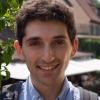Talk Abstract:
Cerebellum and neocortex have jointly expanded throughout mammalian evolution, and together contain ~99% of neurons in the human brain. The two structures are also reciprocally connected by some of the densest long-range projections in the brain, with a near universal pathway from neocortex layer 5 to cerebellar granule cells via the pontine nuclei. In my research I aim to understand the evolution of joint cortico-cerebellar neuronal dynamics that underlie skill learning, and to decipher the computations performed through their communications. By devising a simultaneous two photon calcium imaging preparation for neocortical output neurons and downstream cerebellar granule cells and climbing fibers during weeks-long learning processes, I am characterizing information transmission and transformation between cortex and cerebellum.
Biography:
Mark J. Wagner is a postdoctoral fellow at Stanford University in the Department of Biology advised by Professor Liqun Luo. Mark received his Ph.D. in Neuroscience from Stanford under the supervision of Professor Mark J. Schnitzer. Prior to Stanford, Mark obtained his B.A. and M.S. in Bioengineering at Harvard University, where he studied human motor learning, supervised by Professor Maurice A. Smith. Mark’s current research interests include the communications, distributed computations, and concurrent learning processes between the neocortex and cerebellum, which he studies using multi-site two photon calcium imaging, optogenetics, and viral-genetic anatomical tracing tools.
No need to book, just turn up!
